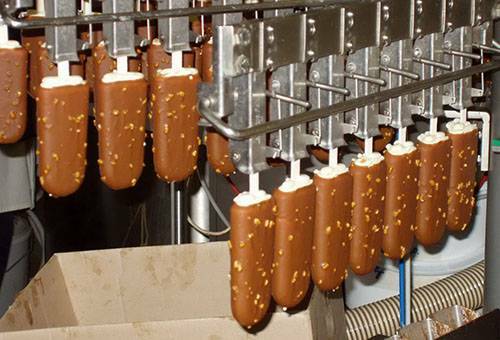Contents:
- What influences the shelf life of ice cream?
- How to store ice cream?
- How much is your favorite ice cream stored?
- How to keep ice cream without a freezer?
- How to store ice cream in a thermos bottle?
Favorite cooling treat of all children and adults melts very quickly, especially on a hot summer day. If you decide to have a picnic, then an ice cream in the thermos will be an excellent way for you. All guests will be extremely surprised when, after a 3-hour trip in the summer heat, you treat them with whole, not melted frozen juice or a creamy popsicle. It is quite feasible, it is only necessary to know the elementary laws of physics.
Ice cream, oddly enough, the find is not at all Europeans or Americans. The French are convinced that it was their "eskimo" that became the progenitor of all modern varieties of ice cream, but this is not so. For the first time, an exotic dessert originated in China. Pamper yourself a new cold dish could only very well-off people. The technology of cooking was kept secret. In fact, the juice of fruits and berries was mixed with ice, getting from this fruit ice.

What influences the shelf life of ice cream?
Like all dairy products, ice cream is dangerous if its shelf life has long expired. The shelf life depends solely on the constituent products: the more natural they are, the quicker the ice cream should be eaten. The main ingredients of the classic cream filling are milk, cream, butter, sweeteners( honey, sugar or molasses) and stabilizer. All products must be fresh and quality, so that the finished ice cream can be stored for a long time.
Before entering the freezer store ice cream goes through many stages of preparation:
- cleaning and filtering of all necessary components;
- pasteurization mixture( heating to 85 degrees for 20 minutes);
- "maturing" ice cream at a temperature of 15 degrees in special containers;
- whipping for the acquisition of the structure of a gentle homogeneous mass;
- hardening at minus 35 degrees;
- packing.
The quality of the paper in which the product is packaged, and the appearance of the packaging depends not only on the integrity of the packaging. Packaging is responsible for the safety of ice cream: if it is broken, the shelf life is reduced, and ice cream can get an unpleasant aftertaste.

How to store ice cream?
To ensure that high-quality products are delivered to our stores, we store them in certain conditions at enterprises. The temperature ranges from -30 to -20 degrees. The main condition is not to subject ice cream to sudden temperature changes. If the mass melts, when it freezes again, it will become hard and lose flavor.
Advice
After buying ice cream, eat it immediately, do not try to freeze the melted product again.
Ice cream in stores should not be in the chamber with other products. It easily absorbs odors. In addition, storage in one chamber with meat can lead to food poisoning. Failure to comply with the rules is fraught with not only damage to your favorite food, but also diseases.

How much is your favorite ice cream stored?
Despite the long-term storage of dairy or fruit and berry ice cream, not stored on packages, it can not be stored for long.
Let's consider the terms of storage of individual types of ice cream.
- Dairy without additives( nuts, jam, condensed milk) - 75 days.
- Dairy with filler - 60 days.
- Creamy - 100 days.
- Plombir( cream and chocolate) - 120 days.
- Fruit and berry - 45 days.
- Fruit ice - 90 days.
The above figures relate to batch desserts, the weight of which is not more than 100 g. Large packages( more than 1 kg) can be stored twice less. All the above dates are valid only if the ice cream is stored at a temperature of no higher than -12 degrees.

How to keep ice cream without a freezer?
If you decide to surprise your friends and take a picnic with you, you can use more simple means than a portable refrigerator. The cooler bag comes first. Yes, in it ice cream can "live" for about 2 hours, but not everyone will want to carry a huge bag with them for the sake of 3 servings of ice cream.
Everyone who, at least a little bit, remembers physics from the school, knows that if a device is able to store heat for a long time, it, accordingly, should keep the cold in itself. If the thermos keeps the heat of brewed tea for a long time on a winter day, why not use it to save ice cream in the summer?
Thermoses come with a glass and metal inner bulb. Metal thermoses are considered more practical, since they are capable of storing heat for 12 hours, while glass ones store it for no more than 6 hours. But the time of keeping the cold in any thermos is the same. The fact is that the vacuum interlayer between the two cylinders contributes to a decrease in the heat transfer coefficient.

How to store ice cream in a thermos bottle?
The main condition for the longest storage of ice cream in a thermos is the lack of free space. If you want to treat a large company and take a weighted plombir with you on a hike, fill them with a thermos up to the neck. Mass should be well tamped with a spoon, so that there are no air layers left. In this state the thermos with ice cream can be stored for up to 4 hours. After 4-5 hours it will begin to melt, and after another couple of hours it can deteriorate and become unsuitable for consumption.
If you take a portioned ice cream with you, do not break the integrity of the package. In a thermos always place ice cubes, they will create additional cold. Ice cream with ice can be stored in a thermos for 5 hours. Carefully inspect the package before placing it in a container: water from melted ice can get into the seal.
Storage of a cold dessert in a thermos depends on the temperature in the street and against sunlight. If you decide to take an ice cream in a thermos on the beach, wrap it in a towel, place it in a bag and put it in the shade. If you leave the thermos in the sun, in an hour ice cream will turn into a warm milkshake.
Preserving ice cream on a summer day without a freezer seems an unrealistic plan, but it's enough to remember the elementary laws of physics, and the solution comes by itself. If you decide to experiment, watch out for time: even in a thermos ice cream can go bad.



